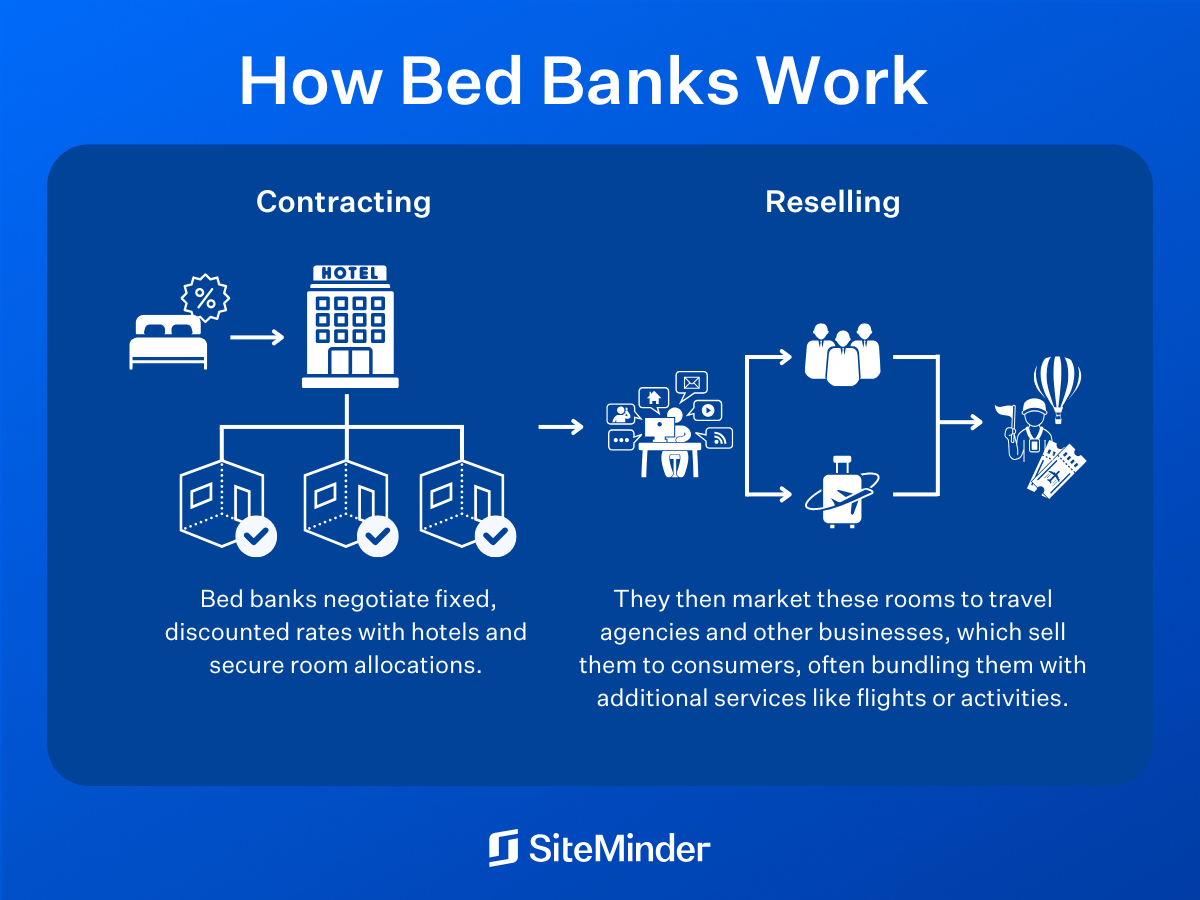What is a bed bank?
A bed bank is a business-to-business (B2B) travel provider that connects hotels with travel distributors, such as online travel agencies (OTAs) and tour operators. Serving as intermediaries in the travel industry, bed banks enable hotels to increase occupancy without directly managing complex distribution channels.
By collaborating with bed banks, hotels gain access to international markets and diverse travel audiences. For instance, a hotel in Australia might use a bed bank to market rooms to European travel agents, significantly expanding its global reach without the need for direct international marketing.
How does the concept of a bed bank work?
Bed banks operate by purchasing large room allotments from hotels at a discounted bulk rate. These rooms are then resold to various travel distributors, such as OTAs, tour operators, and travel agents, who then offer them to end consumers. This model helps hotels fill rooms that might otherwise remain vacant, thereby improving overall occupancy rates without needing extensive marketing efforts or partnerships with multiple distributors.
In the B2B travel sector, bed banks play a pivotal role by serving as a bridge between hotels and distributors, enabling efficient room inventory management and broader market reach. Bed banks negotiate contracts with hotels for specific room blocks, ensuring a steady supply for distributors. In turn, distributors benefit from pre-negotiated rates and availability, which they can offer to their clients.
For example, a medium-sized hotel in a tourist-heavy region might partner with a global bed bank to secure exposure across multiple international markets. The bed bank distributes the hotel’s inventory to various OTAs and travel agents worldwide, attracting guests who might not have found the hotel through direct channels.
This blog will tell you everything you need to know about bed banks, including how you can get connected to them and grow your hotel’s revenue.
Table of contents
Why should hotels use the biggest bed banks?
Partnering with well-established bed banks, such as Hotelbeds, can offer significant advantages for hotels seeking to expand their market reach. Large bed banks have extensive global networks and established relationships with major travel distributors, making it easier for hotels to connect with a broader audience.
In addition to expanding visibility, partnering with major bed banks helps hotels tap into niche markets, such as corporate travel and specialised tour operators. By diversifying their distribution channels, hotels can reduce dependency on direct bookings and ensure a steady stream of revenue.
Tap into new distribution opportunities
With SiteMinder, you can easily automate room inventory and rate updates from your preferred bed bank operators to your PMS, boosting your efficiency and revenue.
Learn more
Benefits of partnering with a global bed bank
Partnering with a global bed bank can unlock significant growth opportunities for hotels by providing broader market access and enhanced revenue potential. Below are some key benefits to consider:
1. Expand your hotel’s visibility and reach niche markets
Partnering with a global bed bank opens doors to untapped international markets and niche audiences. Hotels can gain exposure on platforms that cater to specific types of travellers, such as luxury vacationers or adventure tourists, without the need for direct marketing efforts.
2. Increase bookings and overall hotel revenue
Bed banks help your hotel fill unsold inventory, especially during low seasons. By offering rooms to a wider audience through various travel distributors, hotels can maintain higher occupancy rates year-round and increase overall revenue.

Bed bank list: Who are the major hotel bed banks?
Several key players dominate the bed bank industry, each offering unique services and benefits for hotel partners. Below is a list of some of the leading bed banks:
- Hotelbeds. Hotelbeds is one of the largest and most prominent bed banks, providing access to a global network of travel distributors. Their platform offers advanced tools for inventory management and dynamic pricing.
- WebBeds. WebBeds is known for its extensive reach and competitive commission structures. They cater to a wide range of travel distributors, from OTAs to offline travel agencies.
- Travco. Travco specialises in providing hotels with access to international tour operators and wholesalers, ensuring broad market coverage.
- Bonotel. Bonotel focuses on luxury and boutique hotels, offering tailored services for properties aiming to attract high-end travelers.
- HotelsPro. HotelsPro offers a robust platform for managing room allotments and pricing, with a focus on real-time availability and seamless integration.
Is Hotelbeds a Bed Bank?
Yes, Hotelbeds is one of the most established bed banks in the industry, offering extensive distribution networks and advanced technology solutions for hotels.
Is Expedia a Bed Bank?
No, Expedia is not a traditional bed bank. While it operates as an online travel agency, it collaborates with bed banks to source hotel inventory.
Tips to maximise the purpose of a bed bank for hotels
1. Assess the conditions of bed bank partnerships
Before signing a contract with a bed bank, you must carefully evaluate the terms and conditions, including commission rates, payment schedules, and cancellation policies. This varies from bed bank to bed bank significantly, so check the fine print.
2. Balance bed bank bookings with direct and other sources
While bed banks can significantly boost occupancy, over-reliance on third-party distributors may affect profitability. You should aim for a balanced mix of direct bookings and third-party partnerships – though obviously with direct bookings, you keep more of your revenue.
3. Track and measure bed bank performance
Using performance metrics, such as revenue per available room (RevPAR) and booking lead time, can help you assess the effectiveness of their bed bank partnerships and make data-driven decisions on whether to remain partnered or seek solutions elsewhere.
4. Connect bed banks with existing tech stack
Integrating bed banks with property management systems (PMS) and channel managers ensures seamless updates of room rates and availability, reducing manual workload and minimising errors.

